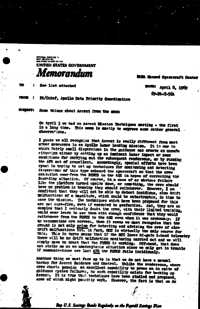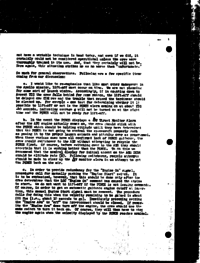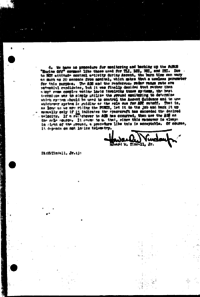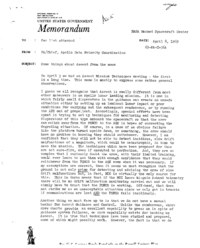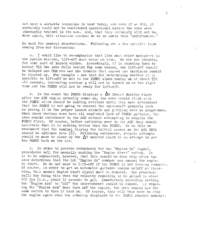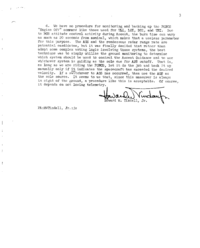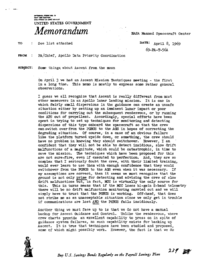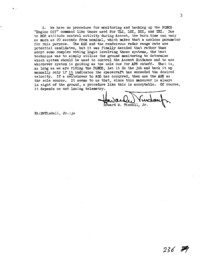See list attachedApril 8, 196969-PA-T-56APA/Chief, Apollo Data Priority CoordinationSome things about Ascent from the moon
On April 3 we had an Ascent Mission Techniques meeting – the first in a long time. This memo is mostly to express some rather general observations.
I guess we all recognize that Ascent is really different from most other maneuvers in an Apollo lunar landing mission. It is one in which fairly small dispersions in the guidance can create an unsafe situation either by setting up an imminent lunar impact or poor conditions for carrying out the subsequent rendezvous, or by running the APS out of propellent. Accordingly, special efforts have been spent in trying to set up techniques for monitoring and detecting dispersions of this type onboard the spacecraft so that the crew can switch over from the PGNCS to the AGS in hopes of correcting the degrading situation. Of course, in a case of an obvious failure like the platform turned upside down, or something, the crew should have no problem in knowing they should switchover. However, I am confident that they will not be able to detect insidious, slow drift malfunctions of a magnitude, which could be catastrophic, in time to save the mission. The techniques which have been proposed for this are not sure-fire, even if executed to perfection. And, they are so complex that I seriously doubt the crew, with their limited training, would ever learn to use them with enough confidence that they would switchover from the PGNCS to the AGS even when it was necessary. If my assumptions are correct, then it seems we must recognize that the ground is not only prime for detecting and advising the crew of slow drift malfunctions but, in fact, MCC is virtually the only source for this. This in turns means that if the MCC loses hi-gain S-band telemetry there will be no drift malfunction monitoring carried out and we will simply have to trust that the PGNCS is working. Off-hand, that does not strike me as an unacceptable situation since we only get in trouble if communications are lost AND the PGNCS fails insidiously.
Another thing we must face up to is that we do not have a manual backup for Ascent Guidance and Control. Unlike the rendezvous, where crew charts provide an excellent capability to press on in spite of guidance system failures, no such capability exists for backing up Ascent. It is true that techniques have been studied and proposed, some of which might possibly work. However, the fact is that we do not have a workable technique in hand today, and even if we did, it certainly could not be considered operational unless the crew were thoroughly trained in its use. And, that they certainly will not be. Here again, this situation strikes me as no worse than “unfortunate.”
So much for general observations. Following are a few specific items coming from our discussion:
a. I would like to re-emphasize that like most other maneuvers in the Apollo mission, lift-off must occur on time. We are not planning for some sort of launch window. Accordingly, if in counting down to Ascent TIG the crew falls behind for some reason, the lift-off should be delayed one CSM rev and the trouble that caused the tardiness should be cleaned up. For example – one test for determining whether it is possible to lift-off or not is the PGNCS alarm coming on at about TIG -40 seconds, indicating average g will not be turned on at the right time and the PGNCS will not be ready for lift-off.
b. In the event the PGNCS displays a ΔV Thrust Monitor Alarm after the APS engine actually comes on, the crew should stick with the PGNCS which should be holding attitude until they have determined that the PGNCS is not going to control the spacecraft properly such as yawing it to the proper launch azimuth and pitching over as programmed. When these various cues have all confirmed lack of PGNCS guidance, the crew should switchover to the AGS without attempting to recycle the PGNCS first. Of course, before switching over to the AGS they should ascertain that it is working better than the PGNCS. To do this we recommend that the nominal display for initial ascent on the AGS DEDA should be altitude rate (Ḣ). Following switchover, recycle attempts should be made to clear up the ΔV monitor alarm in an attempt to get the PGNCS back on the air.
c. In order to provide redundancy for the “Engine On” signal, procedures call for manually pushing the “Engine Start” switch. It is to be emphasized, however, that this should be done only after the crew determines that the LGC “Engine On” command has caused the engine to start. We do not want to lift-off if the PGNCS is not issuing commands. Of course, in order to get an automatic guidance engine cutoff at inser- tion, this manual Engine Start signal must be removed. The procedure calls for doing this when the velocity remaining to be gained is about 200 fps (i.e., about 10 seconds to go). Immediately preceding setting the “Engine Arm” to “off” the interconnect should be closed. If remov- ing the “Engine Arm” does turn off the engine, the crew should use the same switch to turn it back on. Of course, they will then have to stop the engine again when the velocity displayed by the PGNCS reaches nominal.
d. We have no procedure for monitoring and backing up the PGNCS “Engine Off” command like those used for TLI, LOI, DOI, and TEI. Due to RCS attitude control activity during Ascent, the burn time can vary as much as 20 seconds from nominal, which makes that a useless parameter for this purpose. The AGS and the rendezvous radar range rate are potential candidates, but it was finally decided that rather than adopt some complex voting logic involving those systems, the best technique was to simply utilize the ground monitoring to determine which system should be used to control the Ascent Guidance and to use whichever system is guiding as the sole cue for APS cutoff. That is, as long as we are riding the PGNCS, let it do the job and back it up manually only if it indicates the spacecraft has exceeded the desired velocity. If a switchover to AGS has occurred, then use the AGS as the sole source. It seems to us that, since this maneuver is always in sight of the ground, a procedure like this is acceptable. Of course, it depends on not losing telemetry.
- Apr 10, 1969 – Descent monitoring at MCC (4.7σ)
- Mar 20, 1969 – F mission lunar orbit attitude sequence (4.0σ)
- Apr 30, 1968 – CSM should have good rendezvous navigation in the lunar mission (3.2σ)

